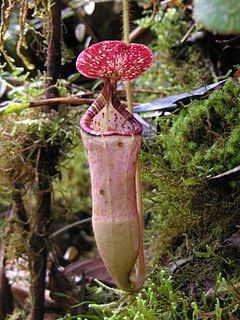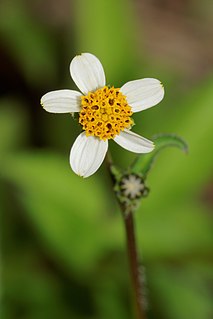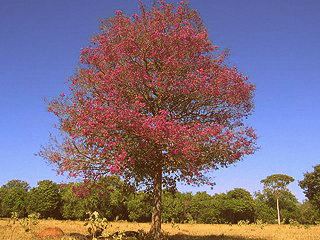
Rosewood refers to any of a number of richly hued timbers, often brownish with darker veining, but found in many different hues.

Hicksbeachia is a genus of two species of trees in the family Proteaceae. They are native to rainforests of northern New South Wales and southeastern Queensland. They are commonly known as red bopple nut or beef nut due to the bright red colour of their fruits.

The order Pilosa is a group of placental mammals, extant today only in the Americas. It includes the anteaters and sloths, including the extinct ground sloths, which became extinct about 10,000 years ago. The name comes from the Latin word for "hairy". Pilosans are good examples of ecological harmony. Anteaters, for example, feed lightly and for a short time at any one ant nest, allowing the colony to regrow easily. Also, sloths' fur is home to many insects, as well as a type of alga that helps camouflage the sloths.

Nepenthes pilosa is a tropical pitcher plant endemic to Borneo. It is characterised by a dense indumentum of long yellow-brown hairs. Pitchers have a distinctive hook-shaped appendage on the underside of the lid. The specific epithet derives from the Latin word pilosus, meaning "hairy".

Rosewood oil is a valuable essential oil, especially in perfumery. It contains the substance linalool, which has a number of uses.

Bidens pilosa is an annual species of herbaceous flowering plant in the daisy family Asteraceae. Its many common names include black-jack, beggarticks, farmer’s friends and Spanish needle, but most commonly referred to as cobblers pegs. It is native to the Americas but is widely distributed as an introduced species in other regions worldwide including Eurasia, Africa, Australia, South America and the Pacific Islands.
Aniba ferrea is a species of plant in the family Lauraceae. It is endemic to Brazil.

Aniba is an American neotropical flowering plant genus in the family Lauraceae. They are present in low and mountain cloud forest in Caribbean islands, Central America, and northern to central South America.
Aniba ferruginea is a species of plant in the family Lauraceae. It is endemic to Venezuela.
Aniba intermedia is a species of plant in the family Lauraceae. It is endemic to Brazil.
Aniba novo-granatensis is a species of plant in the family Lauraceae. It is endemic to Colombia.
Aniba pedicellata is a species of plant in the family Lauraceae. It is endemic to Brazil.
Aniba percoriacea is a species of plant in the family Lauraceae. It is endemic to Suriname.

Aniba rosaeodora, also known as pau-rosa, is a species of Magnoliid tree in the family Lauraceae. Although sometimes wrongly referred to as rosewood this name is totally misleading; it is no tree of the genus Dalbergia. It grows in parts of the tropical rainforest of South America. It is an endangered species that sees exploitation for its essential oil.
Aniba santalodora is a species of plant in the family Lauraceae. It is endemic to Brazil.
Aniba vaupesiana is a species of plant in the family Lauraceae. It is endemic to Colombia.

Grevillea pilosa is a low growing shrub which is endemic to the south-west of Western Australia. It grows to between 0.4 and 1 metre in height and produce red or pink flowers between June and December in its native range.
Hicksbeachia pilosa is a small tree in the family Proteaceae. This rare species is endemic to the rainforests of the wet tropics region of northeastern Queensland, Australia. It was first described in 1988 by Australian botanist Peter H. Weston, after a collection by Garry Sankowsky and Peter Hind in 1986 at Bobbin Bobbin Falls in North Queensland. Its specific name is the Latin adjective pilosus "hairy".
Aniba megaphylla is a species of tree in the family Lauraceae and is native to South America. This species produces the cytotoxic lignan megaphone.

Eusiderin is a neolignan found in Virola sp and Aniba sp.










